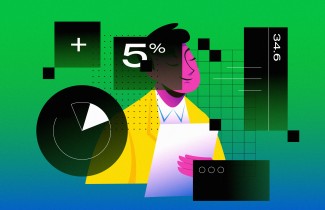Resistance to Change, the Challenge for Universities with Online Education
The challenges that COVID-19 has revealed in higher education in Latin America and the Future of Online Education

The adoption of new technologies has always been a slow process in the education sector. The invention of the printing press marked a milestone in the 15th century, but generated fear in academia of that era regarding its effect on the creative process, which, until then, had been identified with pupils’ written interpretation of the instructor's teachings. The challenges of this change were real, but the transformational potential of the printing press in economics and science was far greater. Nevertheless, achieving the mass use of books in schools and by academics of that era took several decades longer than expected.
While most industries, such as banks, retail and telecommunications, are taking advantage of huge amounts of data, behaviors and predictions about their customers, interacting with them on different digital channels, and getting ready for the impending evolution of big data and artificial intelligence, higher education faces basic infrastructure challenges and a resistance to change. The arrival of COVID-19 has revealed these challenges, producing a tsunami in teachers and in millions of parents who were forced to share their frustration (and home Wi-Fi) with their teenage children.
Tec de Monterrey led the transition to a virtual model given the risk posed by the pandemic. The Business Intelligence course delivered at EGADE switched to the virtual format from one week to the next. The combination of Canvas as an LMS (Learning Management System) and Zoom played a primary role at first, but training, practical improvement sessions, and the numerous platforms and resources available were responsible for assuring a positive transition to the online model. A great deal of vision and many years of investment and challenges were required for this and other prestigious schools to take this leap. Unfortunately, this was not the case in the majority of institutions of higher education.
It took several universities weeks to identify a way to communicate with students and to continue with their normal schedule by means of virtual conferences. After overcoming connectivity challenges (unstable networks with four people connected at the same time using video), teachers and students adopted the new model with a degree of uncertainty when they realized that getting back to normal would take longer than expected. There was not, of course, much time to adjust students’ workload, define the number of hours students could stay in an online class (without losing their attention or the internet connection), or determine the frequency of interactive activities.
Most public universities were simply unable to react and assumed that this situation would be similar to the lengthy strikes they had already faced. At best, they just sent assignments to the students by email or posted them in a depository. Assignments served to keep students busy and reassured parents, but by no means had an effective impact on learning.
Frustration and anxiety were also a consequence of this sudden transition. Students enjoy interacting and participating in extracurricular activities. Graduates rate human relationships, networking and a sense of belonging highly. Students and parents perceive an inferior quality education and are pondering the difficult decision about their permanence next semester. The latest McKinsey Report, dated May 21, estimates a 15% drop in student enrollment in the US university system. This estimate could be similar in Latin America, particularly for students who also have a job.
Why is it so difficult for universities to switch to a virtual model?
Our governments have clearly failed to invest in basic digital infrastructure to guarantee the necessary changes in higher education: nowadays, access to the internet or a computer are obstacles teachers and students have to overcome in order to shift to a virtual model, especially in public universities. However, with this crisis, even universities that had already made progress in their virtualization processes faced the true complexity of a 100% online model.
Online education has long been conceived as the process of virtualizing a traditional classroom either partially (hybrid models) or totally (full online). The reality is that, as in many other industries, the customer profile, expectation and experience are completely different in digital and traditional environments. If I want to buy some shoes at a store, I expect a good location, cordiality and variety. If I want to buy them online, I expect the app to recognize my profile instantly (based on everything I have told Google over the past few months), learn about my likings and preferences while I am browsing, and suggest alternatives or complements.
The world’s top universities develop structures and educators separately for their virtual programs since they understand that they are facing a very different client. Yale, Harvard and Penn have entrusted the creation of many of their online programs to 2U, because this company’s expertise in technology and talent for design and development will assure an end result that is much more in line with the needs of online students… let the cobbler stick to his last.
Not all universities can turn to a third party for this work since the implicit costs and a lack of scale (high volume of students) make it prohibitive. A basic, homemade model could consist of creating courses on a free LMS, such as Google Classroom or Moodle, gradually leading teachers to interact through virtual conference platforms (synchronous learning) and motivating (or forcing) them to post presentation and assignment content on the LMS and be available to students by email (asynchronous learning).
This combination of elements could, however, present risks of scale (greater number of students), use (platforms used as mere document repositories or not at all), and adoption (teachers and students throwing in the towel if they are not satisfied with these environments). The academic community needs not only the right technology tools, but also thorough training in how to align classroom goals with the virtual environment, reschedule activities, generate interaction, divide groups virtually, conduct surveys, administer online evaluations and interact with students offline, among other skills.
Even if schools do all of the above well, online education models imply challenges that are intrinsic to any technology implementation process, the need for change management and the need to maintain consistency across all the courses and programs.
A hybrid model, in which students also experience face-to-face interaction, offers compensation and allows mistakes to be remedied. In a full online model, such as the one warranted by the current situation, planning, investment in infrastructure, consensual assessment, and several iterations of trial and error are required.
Assuming that instruction takes the plunge, is there anything beyond a virtual class and long assignments?
Open access tools such as Kahoot, Quizlet, Google Forms and Socrative, which are used in synchronous virtual classes, positively enrich virtual environments, allow educators to evaluate their students informally, and increase participation and motivation. The content of YouTube and other platforms (some of excellent quality) fulfill their task of reinforcing learning, but leave huge challenges for universities and educators. How can content be aligned with the curricular objectives? Who guarantees the quality of the content? How can students be guided? How can learning be evaluated?
Teaching and evaluating mathematics is not the same as teaching history or biology. Assuming that a single tool will meet 100% of the academic community’s needs is risky. Universities such as NYU, National Singapore University (NSU) and Yale use Cengage’s WebAssign platform for Mathematics and Physics. This platform allows the teacher to schedule classes, design assignments and exams for students (different versions for each student), grade them and provide personalized feedback. If students get a question wrong, they can practice with a similar question and IF the teacher wants proof, the student can send him or her a photo of the process.
PhET (available in Spanish), of the University of Colorado, and Labster offer simulators for Chemistry, Biology and other areas, enabling teachers to provide a virtual replacement for students’ experience in physical laboratories. Students interact in a virtual environment that makes density or differential equations real in a highly didactic manner.
Universities worldwide are going all out to provide digital libraries for their students. Students can borrow and return a book digitally; open the text in their LMS on the page of the book their teacher defined as relevant to the topic; access the text with or without a network on any device. Resource ubiquity and accessibility are becoming increasingly important.
Solutions such as SimCase, used at Wharton and Kellogg, allow teachers to move classic classroom activities to smartphones. The typical negotiation exercise in which two students take on the roles of the buyer and the seller is now conducted on their mobiles, thereby enabling the teacher to review the negotiation process, observe the strategies used (launching a killer offer versus offering successive discounts), and compare each student’s effectiveness individually.
Finally, our education systems across the world are still closely linked to traditional and quantitative evaluations. While we are moving towards a better system, universities need to rethink their entrance and end-of-course exams. Assessment and proctoring tools, such as Proctor U, PSI or Respondus, allow educational institutions to create and administer exams, while guaranteeing academic integrity. The application verifies students’ identity by means of a webcam, blocks their access to other screens on the browser and provides educators with a huge bank of questions.
Online education and classroom education are going to be coexisting for a long time to come. Reaction rates, modality mix and speed of adoption will be varied and depend on the vision and leadership of institutions and governments.
Right now, online and virtual education are yet to compete one on one, but this will begin to change with the adoption of technologies such as virtual reality and the growth of artificial intelligence and blockchain. It won’t be long before we have a virtual assistant like Paul at the Saint Paul Business School in Brazil, which will suggest a learning track with courses and programs aligned to our personal needs, rapidly learn our preferences, know whether we learn better with videos, synchronous classes or podcasts during the day, and decide which materials to propose for preparing our next exam according to our available hours.
A Machine Learning Assistant of the future will be able to decide which university delivers the best design course in the world and enroll us automatically. An integrated, secure system based on blockchain will validate our learning so that the university can validate competency (and credits) and an employer or client can instantly locate us when they need a specific talent.
The growth of online education will not only be marked by scenarios similar to COVID, but also by the pressing need to generate data that will ultimately give us insight into how our students learn best, something that traditional education has failed to do. The future of education will without doubt be a terrific scenario for learning and relearning.
Also published in Alto Nivel.



